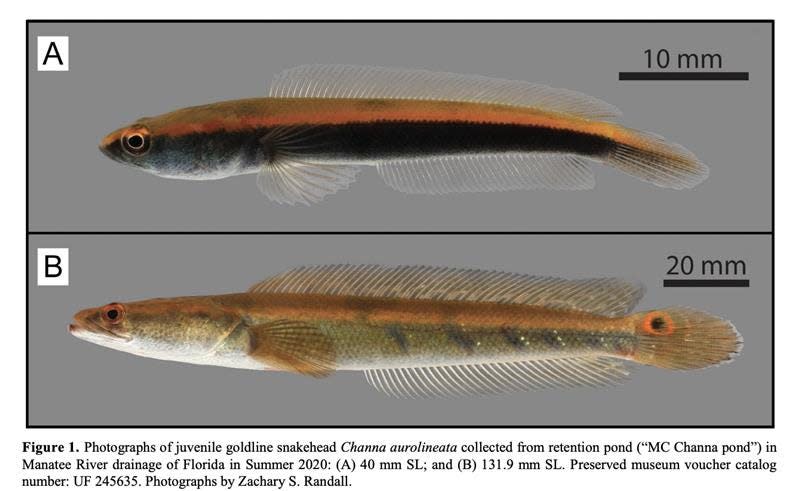Airbreathing, frog-hunting snakehead fish found in Manatee County. Here's what to know.
An aggressive, airbreathing, frog-killing fish was discovered living in a Manatee County freshwater pond, according to a recent study from the University of Florida’s Museum of Natural History.

This is the first documented occurrence of the suave-named goldline snakehead fish in Gulf Coast waters. Snakeheads are native to Myanmar and western Thailand but were introduced to the wild worldwide for their popularity in ornamental fish trades and sport fishing.
Where in Manatee were they found?
The snakeheads were captured at a large, unnamed freshwater pond located in the Williams Creek watershed, a tributary of the Braden River.
ICYMI:Reporter's notebook: Covering Hurricane Ian created a whirlwind of emotion for me
More:Manatee County teachers close class libraries, fearing prosecution under new Florida law
Officials with the Florida Fish and Wildlife Conservation Commission captured nearly 400 snakeheads from June 2020 — the initial discovery — through May 2021. Field scientists completed numerous visual surveys by hand or boat electrofishing, finding the fish most often along the pond’s perimeter and vegetation. There were no confirmed sightings or evidence of snakeheads in any other waterways outside of the pond, according to the study.
Are goldline snakeheads harmful to our local ecosystem?
Yes. The predatory fish are exceptionally strong — able to withstand diverse environmental conditions including drought.
“Any reproducing non-indigenous species has the potential for deleterious effects on the environment to which it has been introduced,” said Robert Robins, ichthyology collection manager at the Florida Museum of Natural history and co-author of the study. “Most never become invasive, but some do.”
Local snakeheads were observed hunting frogs, a behavior rarely seen in the wild. According to the study, several snakeheads slithered onto the grassy pond bank, lured by green tree frogs hopping along the water's edge. When the fish were within striking distance, they leaped onto their prey, rapidly twisting their upper body in the direction of the frog and drowning them underwater for a successful catch. While snakeheads are known to move over land, their ability to feed while doing so emphasizes the fish’s potential negative impact.
How did the non-native fish get here?
Scientists compared features of the godlike snakeheads found in Manatee County to those found in Broward County in 2000. The two populations are nearly identical, and both share a strong genetic relation with snakeheads from the Mae Klong river basin in Thailand.
Due to the bicoastal geography, researchers believe the snakeheads in Manatee County are likely the result of human transport between sites rather than natural animal migration.
Should I be worried about snakeheads spreading?
Right now, it doesn't seem like it. FWC biologists removed several hundred snakeheads in late 2020 and early 2021 in a successful eradication effort. According to the report, no additional snakeheads have been sighted since these operations, including a post-treatment survey conducted in January.
This article originally appeared on Sarasota Herald-Tribune: Invasive snakehead fish species discovered in Manatee County by scientists

